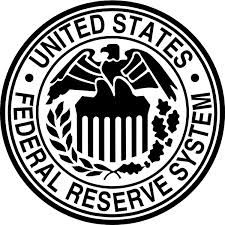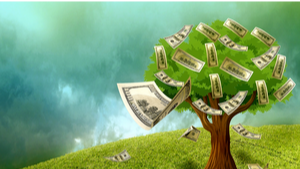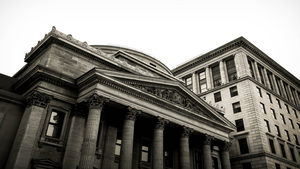S&P 500: -0.33% DOW: -0.36% NASDAQ: -1.11% 10-YR: 1.23%

Last Week on WallStreet - July 31
What Happened
A slew of strong economic data and an uneventful Fed meeting were not enough to keep the major indexes climbing higher. Earnings reports were once again the focal point, and investors were disappointed in the weaker Q3 and Q4 outlooks given by many companies. Executives frequently mentioned headwinds related to supply chain constraints and higher input costs which will keep the inflation debate front and center in coming months. Beneath the surface, Materials (+2.8%), Energy (+1.8%), and Financials (+0.7%) outperformed, while Communications (-1.3%), Consumer Discretionary (-1.6%), and Technology (-0.7%) were dragged lower by disappointing earnings.
- The Fed stays put
- GDP tops pre-COVID levels
- Consumer sentiment falls
- IMF's take on 'transitory' inflation
- New home sales decline
- Interesting articles from the Waterloo Watercooler

Thomas Franck - CNBC
Fed Says Progress Made, but No Tapering Yet
The Federal Reserve held interest rates and its asset purchase program in place as policy makers continued to focus on hitting employment and inflation goals. Fed Chairman Jerome Powell said the economy is still "a ways off" from the levels where the Fed will begin reducing their bond purchases and potentially raise interest rates. The Fed's inaction was largely expected, and investors will continue to listen for forward guidance as to when the tapering process will begin.
The key takeaway is the Fed has continued to let everyone know they are thinking about tapering, but the economy still has room for improvement. It now looks unlikely that we will see any adjustment in Fed policy until September at the earliest and might not see tapering until the end of this year or 2022. Lower interest rates are likely to continue bolstering demand for risk assets given the weak yield and return profile for many fixed income securities.

Jeffry Bartash - MarketWatch
US Economy Tops pre-COVID Level with GDP Surging at 6.5% Pace in the Spring
The U.S. economy grew rapidly in the spring and repaired most of the damage caused by the pandemic thanks to widespread coronavirus vaccinations and a nearly full reopening of the economy. Gross domestic product, the official scorecard for the economy, expanded at a 6.5% annual pace in the second quarter. The size of the economy now exceeds pre-pandemic levels after a short but deep recession last year. Consumer spending, the main engine of the economy, rocketed 11.8% higher in the spring at an annual pace. That’s four times faster than the typical increase each quarter.
The key takeaway is that the surge in growth in the Spring gave the economy plenty of momentum heading into the third quarter, but the GDP is mostly a look in the rearview mirror. It tells us where the economy has been, but not where it’s going. The good news is, the economy appears to have plenty of staying power. The economy will have to do without trillions of dollars in government financial stimulus, but as long as coronavirus cases stay low, the recovery should forge ahead at an accelerated pace.

Chris Matthews - MarketWatch
US Consumer Sentiment Falls in July as Inflation Expectations Hit 13-year High
The reading of the University of Michigan’s consumer sentiment index fell to 81.2 in July from a reading of 85.5 in June. This was higher than expected as economists had forecast a reading of 80.5. Consumers remained guarded about the general health of the economy, with near-term inflation remaining at top of mind. Expectations for inflation over the next year rose to 4.7% from 4.2% in June and remain higher than they’ve been for more than a decade. A sub-index that measures how consumers feel about the economy right now fell to 84.5 in July’s reading from 88.6 in June.
The key takeaway is that prices in June rose by the largest amount since 2008, so it’s no surprise that inflation remains a serious concern for American consumers. However, this has not stopped Americans from spending as trends in that area get back to pre-COVID numbers. As personal income rose this month despite decreasing government spending, it seems as though American's could be geared up for this drive-up in prices.

Nick Timiraos - WSJ
IMF Warns Rising Inflation Could Last Longer than Expected
The International Monetary Fund warned on Tuesday that a recent inflation burst could prove longer-lasting than expected, forcing central banks across the world to take action to address the rising cost of goods and services. This announcement on Tuesday coincides with Jerome Powell's press conference from Wednesday in which he admitted inflation has risen higher than expected but still believes it will fade away. Both the IMF and Powell cited supply bottlenecks are playing a large role in this inflation.
The key takeaway is that more and more people are taking notice of inflation. There are now two key economic players warning that this could last longer than expected. This differs from their previous statements saying it will only be temporary. These new comments could very well be wrong and inflation could be temporary, but the shift in tone is something to keep an eye on. The inflation data that will be released in August will be anxiously awaited.

Jeffry Bartash - MarketWatch
Sales of New Homes Sink to Lowest Level since Pandemic
Sales of new homes in the U.S. fell in June to the lowest level since the first month of the U.S. coronavirus pandemic in early 2020, as high prices and a limited selection frustrated scores of would-be buyers. New-home sales dropped 6.6% to an annual rate of 676,000, this decline in sales was much larger than Wall Street had expected. Economists polled by the Wall Street Journal forecast an annual sales rate of 795,000. New-home sales had leaped in January to the highest level in almost 15 years, however, since then the numbers have quickly fallen back to Earth.
The key takeaway is that plenty of people want to buy homes, but high prices and a limited selection are the biggest obstacles. The average cost of a new home is about 12% higher compared with a year earlier. These higher prices are the result of strong customer demand and more expensive building materials along with labor. These problems are expected to act as a drag on the housing market for months to come.

From the Waterloo Watercooler
Interest rates haven’t been this low in 5,000 years.
The massive social safety net that Congress put in place to financially support millions of Americans reeling from the coronavirus pandemic is unraveling.
China's escalating crackdown on business is moving stocks.
Robinhood shares finished lower Thursday in a difficult opening session for the popular, yet controversial, online trading app.
New CDC indoor mask rule may threaten economic momentum and upend return-to-work plans.
Keep track of the Olympics with an official medal count.
